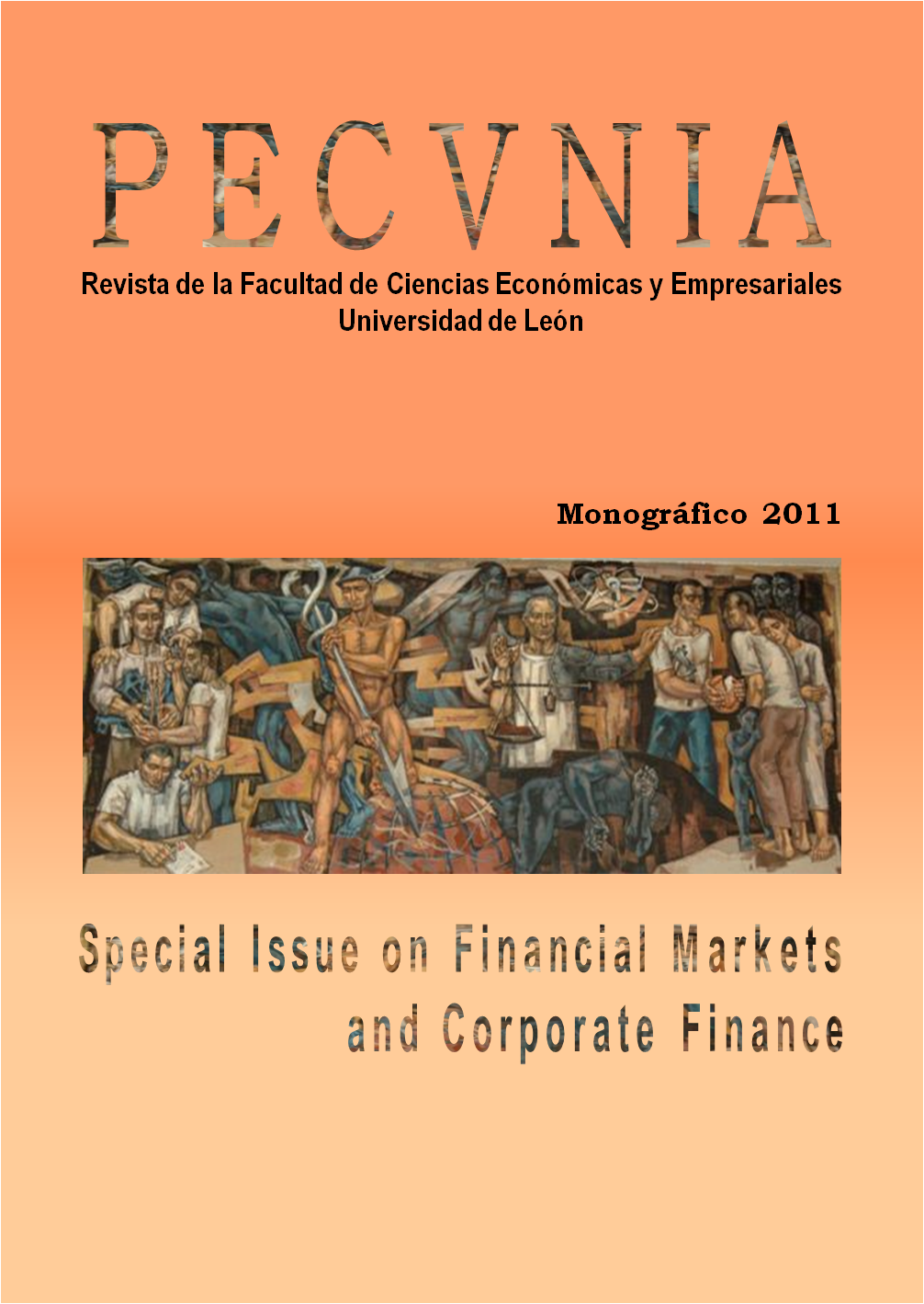Concentración de propiedad y valor de mercado en la empresa familiar : un enfoque de gobierno corporativo
DOI :
https://doi.org/10.18002/pec.v0i2011.754Mots-clés :
Empresa familiar, Concentración de propiedad, Valor de mercado, No linealidades, Gobierno corporativo, Datos de panel, Family firm, Ownership concentration, Firm value, Nonlinearities, Corporate governance, Panel dataRésumé
Dada la importancia de las empresas familiares en todo el mundo, nuestro principal objetivo en este trabajo es investigar la relación entre concentración de propiedad y valor de mercado en elcaso particular de las compañías familiares. Además, estudiamos si las empresas familiares obtienen mejores resultados que las no familiares. Para lograr este objetivo, adoptamos un enfoque de gobierno corporativo. La estimación de nuestros modelos mediante el método generalizado de los momentos proporciona nueva evidencia empírica. Nuestros resultados revelan que la propiedad familiar influye positivamente en el valor empresarial. No obstante, cuando laconcentración de propiedad en manos de la familia es demasiado elevada, el valor de la compañía disminuye; dando lugar a un relación no lineal entre concentración de propiedad familiar y valor de mercado. Finalmente, demostramos que las empresas familiares obtienen mejores resultados que las no familiares, incluso cuando se tiene en cuenta la mencionada no linealidad. En general, losresultados obtenidos indican que el control familiar de las empresas puede ser beneficioso para los accionistas minoritarios.Given the importance of family firms all over the world, our main objective in this paper is to investigate the relation between ownership concentration and the market value of the company inthe particular case of family firms. Additionally, we study whether family firms outperform nonfamily corporations. To this aim, we adopt a corporate governance approach. The estimation of ourmodels by using the generalized method of moments provides new empirical evidence. Our results show that family ownership impacts positively on firm value. Nevertheless, when ownership concentration in the hands of the family is too high, firm value decreases; thus giving rise to a nonlinear relation between family ownership concentration and firm value. Finally, we find that familyfirms perform better than non-family ones, even when nonlinearities are taken into account. Overall, our findings suggest that family control of corporations may be beneficial to minority shareholders.
Téléchargements
Références
Anderson, R.C. y Reeb, D.M. (2003). “Founding-family ownership and firm performance: Evidence from the S&P 500”, Journal of Finance, 58, pp. 1301–1328.
Anderson, R.C.; Mansi, S.A. y Reeb, D.M. (2003). “Founding family ownership and the agency cost of debt”, Journal of Financial Economics, 68, pp. 263–285.
Arellano, M. y Bond, S. (1991). “Some tests of specification for panel data: Monte Carlo evidence and an application to employment equations”, Review of Economic Studies, 58, pp. 277–297.
Barontini, R. y Caprio, L. (2006). “The effect of family control on firm value and performance: Evidence from continental Europe”, European Financial Management, 12, pp. 689–723.
Barth, E.; Gulbrandsen, T. y Schone, P. (2005). “Family ownership and productivity: The role of owner–management”, Journal of Corporate Finance, 11, pp. 107–127.
Berle, A.A. y Means, G.C. (1932). The modern corporation and private property. New York, NY: MacMillan Co.
Bhattacharya, U. y Ravikumar, B. (2001). “Capital markets and the evolution of family business”, Journal of Business, 74, pp. 187–220.
Blundell, R. y Bond, S. (1998). “Initial conditions and moment restrictions in dynamic panel data models”, Journal of Econometrics, 87, pp. 115–144.
Claessens, S.; Djankov, S. y Lang, L.H.P. (2000). “The separation of ownership and control in East Asian corporations”, Journal of Financial Economics, 58, pp. 81–112.
Cronqvist, H. y Nilsson, M. (2003). “Agency costs of controlling minority shareholders”, Journal of Financial and Quantitative Analysis, 38, pp. 695–719.
Dahya, J.; Dimitrov, O. y McConnell, J.J. (2008). Dominant shareholders, corporate boards and corporate value: A cross-country analysis”, Journal of Financial Economics, 87, pp. 73–100.
DeAngelo, H. y DeAngelo, L. (2000). “Controlling stockholders and the disciplinary role of corporate payout policy: A study of the Times Mirror Company”, Journal of Financial Economics, 56, pp. 153–207.
Demsetz, H. (1983). “The structure of ownership and the theory of the firm”, Journal of Law and Economics, 26, pp. 375–390.
Denis, D. y Denis, D. (1994). “Majority owner–managers and organizational efficiency”, Journal of Corporate Finance, 1, pp. 91–118.
Denis, D.K. y McConnell, J.J. (2003). “International corporate governance”, Journal of Financial and Quantitative Analysis, 38, pp. 1–36.
Faccio, M. y Lang, L.H.P. (2002). “The ultimate ownership of Western European corporations”, Journal of Financial Economics, 65, pp. 365–395.
Faccio, M.; Lang, L.H.P. y Young, L. (2001). “Dividends and expropriation”, American Economic Review, 91, pp. 54–78.
Fama, E.F. y Jensen, M.C. (1983). “Separation of ownership and control”, Journal of Law and Economics, 26, pp. 301–325.
Franks, J. y Mayer, C. (2001). “Ownership and control of German corporations”, Review of Financial Studies, 14, pp. 943–977.
Gadhoum, Y.; Lang, L.H.P. y Young, L. (2005). “Who controls U.S.?”, European Financial Management, 11, pp. 339–363.
Gedajlovic, E. y Shapiro, D. (1998). “Management and ownership effects: Evidence from five countries”, Strategic Management Journal, 19, pp. 533–553.
Gómez-Mejia, L.; Nunez-Nickel, M. y Gutierrez, I. (2001). “The role of family ties in agency contracts”, Academy of Management Journal, 44, pp. 81–95.
Holderness, C.G. y Sheehan, D.P. (1988). “The role of majority shareholders in publicly held corporations: An exploratory analysis”, Journal of Financial Economics, 20, pp. 317–346.
James, H.S. (1999). “Owner as manager, extended horizons and the family firm”, International Journal of the Economics of Business, 6, pp. 41–55.
Jensen, M.C. y Meckling, W.H. (1976). “Theory of the firm: Managerial behavior, agency costs and ownership structure”, Journal of Financial Economics, 3, pp. 305–360.
Lam, K.; Mok, H.M.K.; Cheung, I. y Yam, H.C.S. (1994). “Family groupings on performance of portfolio selection in the Hong Kong stock market”, Journal of Banking and Finance, 18, pp. 725–742.
La Porta, R.; Lopez-de-Silanes, F. y Shleifer, A. (1999). “Corporate ownership around the world”, Journal of Finance, 54, pp. 471–517.
La Porta, R.; Lopez-de-Silanes, F.; Shleifer, A. y Vishny, R. (1998). “Law and finance”, Journal of Political Economy, 106, pp. 1113–1155.
Lemmon, M.L. y Lins, K.V. (2003). “Ownership structure, corporate governance and firm value: Evidence from the East Asian financial crisis”, Journal of Finance, 58, pp. 1445–1468.
Lewellen, W. y Badrinath, S. (1997). “On the measurement of Tobin’s Q”, Journal of Financial Economics, 44, pp. 77–122.
Lins, K.V. (2003). “Equity ownership and firm value in emerging markets”, Journal of Financial and Quantitative Analysis, 38, pp. 159–184.
Martikainen, M.; Nikkinen, J. y Vähämaa, S. (2009). “Production functions and productivity of family firms: Evidence from the S&P 500”, Quarterly Review of Economics and Finance, 49, pp. 295–307.
Maury, B. (2006). “Family ownership and firm performance: Empirical evidence from Western European corporations”, Journal of Corporate Finance, 12, pp. 321–341.
McConaughy, D.L.; Walker, M.C.; Henderson, G.V. y Mishra, C.S. (1998). “Founding family controlled firms: Efficiency and value”, Review of Financial Economics, 7, pp. 1–19.
Miguel, A. y Pindado, J. (2001). “Determinants of capital structure: New evidence from Spanish panel data”, Journal of Corporate Finance, 7, pp. 77–99.
Miguel, A.; Pindado, J. y de la Torre, C. (2004). “Ownership structure and firm value: New evidence from Spain”, Strategic Management Journal, 25, pp. 1199–1207.
Miller, D.; Le Breton-Miller, I.; Lester, R.H. y Cannella, A.A. (2007). “Are family firms really superior performers?”, Journal of Corporate Finance, 13, pp. 829–858.
Mok, H.M.K.; Lam, K. y Cheung, I. (1992). “Family control and return covariations in Hong Kong’s common stocks”, Journal of Business Finance and Accounting, 19, pp. 277–293.
Morck, R.; Wolfenzon, D. y Yeung, B. (2005). “Corporate governance, economic entrenchment and growth”, Journal of Economic Literature, 43, pp. 655–720.
Shleifer, A. y Vishny, R.W. (1986). “Large shareholders and corporate control”, Journal of Political Economy, 94, pp. 461–488.
Shleifer, A. y Vishny, R.W. (1997). “A survey of corporate governance”, Journal of Finance, 52, pp. 737–783.
Thomsen, S. y Pedersen, T. (2000). “Ownership structure and economic performance in the largest European companies”, Strategic Management Journal, 21, pp. 689–705.
Villalonga, B. y Amit, R. (2006). “How do family ownership, control and management affect firm value?”, Journal of Financial Economics, 80 (2), pp. 385–418.
Wang, D. (2006). R. “Founding family ownership and earnings quality”, Journal of Accounting Research, 44 (3), pp. 619–656
Téléchargements
Publié-e
Comment citer
Numéro
Rubrique
Licence
(c) Tous droits réservés Julio Pindado, Ignacio Requejo, Chabela De la Torre 2013

Cette œuvre est sous licence Creative Commons Attribution - Pas d'Utilisation Commerciale - Partage dans les Mêmes Conditions 4.0 International.
Los autores que publican en esta revista están de acuerdo con los siguientes términos:- Los autores ceden de forma no exclusiva los derechos de explotación (reproducción, distribución, comunicación pública, transformación) a la Universidad de León, por lo que pueden establecer, por separado, acuerdos adicionales para la distribución no exclusiva de la versión de la obra publicada en la revista (por ejemplo, alojarlo en un repositorio institucional o publicarlo en un libro), con un reconocimiento de su publicación inicial en esta revista.
- Este trabajo se encuentra bajo la Creative Commons Attribution-NonCommercial-ShareAlike 4.0 International License. Puede consultarse desde aquí la versión informativa y el texto legal de la licencia.
- Se permite y se anima a los autores a difundir electrónicamente las versiones pre-print (versión antes de ser evaluada) y/o post-print (versión evaluada y aceptada para su publicación) de sus obras antes de su publicación, ya que favorece su circulación y difusión más temprana y con ello un posible aumento en su citación y alcance entre la comunidad académica.












